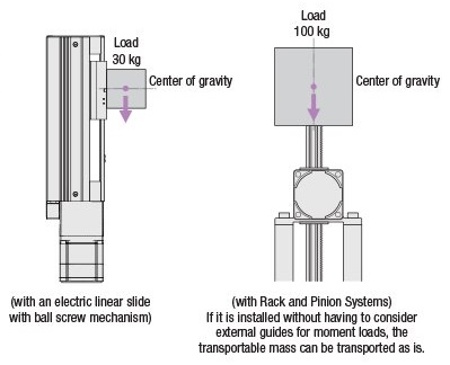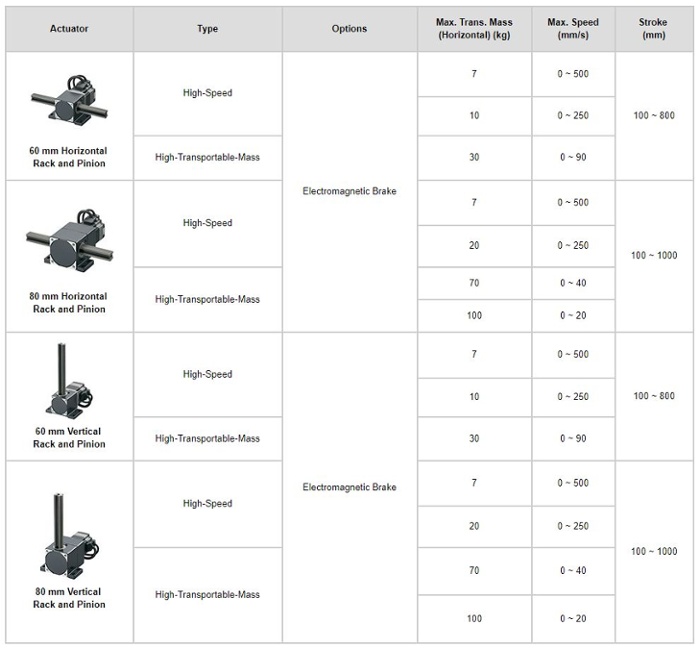There are many mechanisms that convert rotary motion of an electric motor to linear motion, such as belt/chain drives, screw drives, rack & pinion drives and even CAM drives. Each mechanism offers advantages and disadvantages. Choosing the right technology can help increase load, speed, travel distance, or positioning accuracy.

|
Belt & Pulley - recognized for their long travel and high speeds, belt drives have low initial cost and are popular for general purpose applications. However, after a certain length, tensioning of the belt becomes an issue. Its typical polyurethane belts are usually reinforced with steel, and the lack of rolling elements helps withstand harsh environments. The drawback of belts is that they are elastic and can stretch or wear over time. Therefore, belt drives are not recommended for high precision or vertical applications with high acceleration rates or heavy loads. The elasticity of belts also increase resonance and settling time more than other mechanisms. For light loads traveling horizontally, belts typically are sufficient. |
 |
| Lead/Ball Screw - combined with either a lead screw or a more efficient ball screw with a fine pitch/lead, screw drives can achieve high thrust forces and greater positioning accuracy and repeatability than other mechanisms, but at a higher cost and lower speed. When the travel distance is increased by extending the length of the screw, the screw's whipping effect decreases the max permissible speed. Additional screw support structure can reduce the whipping effect, but it increases both the cost and footprint. The inefficiency of the lead screw can be used as an advantage to provide holding force for vertical loads, while the high efficiency of ball screws allow higher torque conversion to thrust force. |  |
|
Rack and Pinion - known for their long strokes, rack and pinion drive systems virtually have no limit on travel length as long as the rack can be made long enough. The max travel length is instead limited by its support structure. By using a rack instead of a belt, elasticity is eliminated, and rigidity is increased. However, since a rack is heavier than a belt, some speed is sacrificed. Rack and pinion systems are ideal for applications such as vertical lifts or overhead gantries. Its design also allows multiple carriages to be used on one system, which is useful for applications that require loads to move independently. The difference in the design and machining quality of the racks makes a difference in performance in noise or accuracy. |
 |
Here's a quick comparison table for the 3 mechanisms discussed.

So which mechanism is the best? It depends on the job.

Various electric linear motorized slides, cylinders, and actuators are offered with ball screw, belt as well as rack and pinion technology to suit different requirements. For an application that requires a high load but doesn't require the precision of screws, a rack and pinion system makes sense.
Jump to the DEMO VIDEO to see an application example, or if you have some time to burn, read on to let me tell you why Oriental Motor's rack and pinion systems can resolve some typical linear motion mechanism challenges.

Increasing load mass is difficult when ball screws are used.
Heavier loads have more weight and mass. Motorized slides with ball screws typically carries the load on a carriage that moves along the outside of screw; therefore additional moment load considerations may be necessary for heavier loads. Increasing the load from 30 kg to 100 kg with the ball screw example below can increase the moment load, potentially exceeding the specification and thus requiring additional guide support. Rack and pinion systems can reduce the need for external support while increasing transportable mass for vertical applications.

Ball screws and cams are difficult to obtain.
Ball screws are highly advanced mechanisms with rolling elements, and cams are not easy to design. Typically, lead times are long for these parts. It's possible for engineers to build their own, but a significant amount of engineering resources is necessary.

Credit: https://en.wikipedia.org/wiki/Cam
Wiring for sensors and other devices is complicated.
For position control applications, a homing routine is necessary for ensuring the same starting position every time and maintaining accuracy. For a typical motor, 3 sensors are used for home, + limit, and - limit. By using a motor with an built-in multi-rotation absolute encoder, these sensors and the time required for installation and testing can be eliminated. Some new types of absolute encoders do not need a backup battery and can eliminate maintenance requirements associated with them.
 |
 |
Improved equipment performance is desired.
Closed-loop stepper motor technology has advanced since its introduction. With Oriental Motor's patented "ABZO"  in the AZ Series stepper motor, multiple rotations of absolute coordinates are are available without the need for a backup battery, and slow homing speeds or missed steps are now history.
in the AZ Series stepper motor, multiple rotations of absolute coordinates are are available without the need for a backup battery, and slow homing speeds or missed steps are now history.
The patented  improves stepper motor performance by combining the best of both closed-loop and open-loop control. Advanced motion sequence programming from the AZ Series such as looped operations and conditional event triggers helps reduce burden on the PLC and makes motion programming easy even for non-engineers.
improves stepper motor performance by combining the best of both closed-loop and open-loop control. Advanced motion sequence programming from the AZ Series such as looped operations and conditional event triggers helps reduce burden on the PLC and makes motion programming easy even for non-engineers.
 |
 |
|
We set up a test to compare the homing accuracy between a photo sensor and the ABZO sensor. |
Here we show how the L Series rack and pinion systems can help automate a process. The advanced motion sequence programming of the dedicated drivers can help reduce burden on the PLC or HMI.
By combining its best closed loop motor technology with a high capacity, long stroke rack and pinion mechanism in the L Series, Oriental Motor offers a 100 kg max load capacity at up to 1 meter stroke with highly reliable servo-like performance with no tuning. In addition, the motor's patented  technology minimizes heat generated and allows high duty cycles for increasing throughput of a machine. Multi-axis and fieldbus network capability are available through various drivers. Combined with its extensive remote status monitor functions, predictive maintenance is also possible.
technology minimizes heat generated and allows high duty cycles for increasing throughput of a machine. Multi-axis and fieldbus network capability are available through various drivers. Combined with its extensive remote status monitor functions, predictive maintenance is also possible.
 |
 |
|
Oriental Motor offers easy sizing for linear motion systems. Easily pick a part number by selecting your required type, load, speed and stroke.
That's all folks! Remember to subscribe.












